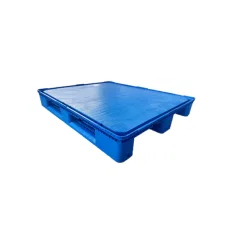How Steel Pallets Can Improve Your Warehouse Efficiency
2024-09-21
Efficiency is a critical factor in the success of any warehouse operation. From optimizing storage space to streamlining the movement of goods, every decision impacts productivity and profitability. One often-overlooked aspect of warehouse efficiency is the choice of pallets. In this blog post, we’ll discuss how steel pallets can significantly improve your warehouse efficiency and give your business a competitive edge.
1. Increased Strength and Stability
Steel pallets provide superior strength and stability compared to wooden or plastic pallets. This increased stability ensures that goods can be stacked more securely and efficiently, reducing the risk of accidents and product damage. In a busy warehouse environment, minimizing product loss is key to maintaining profitability.
With steel pallets, warehouse workers can handle heavier and bulkier items with greater ease, reducing the need for excessive packaging or protective measures. This not only saves time but also cuts down on material costs, allowing for a more streamlined and efficient operation.
2. Improved Space Utilization
Warehouse space is often at a premium, and maximizing the available space is essential for running an efficient operation. Steel pallets are designed with uniform dimensions, making it easier to standardize storage and optimize the layout of your warehouse. Unlike wooden pallets, which can warp or break over time, steel pallets maintain their shape, allowing for more precise stacking and storage.
Additionally, the strength of steel pallets allows for higher stacking in vertical storage systems, making better use of overhead space. This improved space utilization helps increase storage capacity without the need to expand the physical size of your warehouse.
3. Better Compatibility with Automated Systems
Automation is becoming increasingly prevalent in modern warehouses, with systems such as automated guided vehicles (AGVs) and robotic palletizers being used to improve efficiency and reduce labor costs. Steel pallets are particularly well-suited to these automated systems due to their uniform structure, durability, and precise handling capabilities.
Unlike wooden pallets, which can be inconsistent in shape or prone to breaking, steel pallets provide the consistency needed for automated handling equipment to operate smoothly. This compatibility with automation allows for faster, more reliable movement of goods throughout the warehouse, reducing downtime and increasing productivity.
4. Reduced Maintenance and Repair Costs
Warehouses often face the challenge of maintaining pallets and dealing with repairs or replacements. Wooden pallets, in particular, require regular maintenance due to wear and tear, splintering, or damage from heavy loads. Steel pallets, however, are highly durable and resistant to damage, resulting in significantly lower maintenance costs.
By investing in steel pallets, warehouse managers can reduce the frequency of pallet replacement, leading to less downtime for repairs and fewer disruptions to the supply chain. This longevity also translates to long-term cost savings, as the need for pallet repair or replacement is minimized.
5. Environmental Benefits and Sustainability
Many companies are increasingly focused on sustainability, and steel pallets offer an environmentally friendly option. Steel is fully recyclable, and the long lifespan of steel pallets means fewer pallets need to be produced over time, reducing overall resource consumption.
Furthermore, using steel pallets can help warehouses meet sustainability goals by reducing the need for disposable materials, such as wooden pallets, that often end up in landfills. The durability of steel pallets also means that fewer raw materials are required for replacements, further reducing the warehouse’s environmental footprint.
6. Enhanced Safety for Workers
Worker safety is a top priority in any warehouse setting, and steel pallets can contribute to a safer work environment. Wooden pallets can splinter, break, or collapse under heavy loads, posing a risk to employees handling them. Steel pallets, however, are much stronger and less prone to damage, reducing the likelihood of accidents.
Additionally, steel pallets are fire-resistant, offering an extra layer of safety in warehouses where flammable materials are stored. By minimizing the risks associated with pallet handling and fire hazards, steel pallets help create a safer workplace for employees.
Conclusion
Switching to steel pallets in your warehouse can lead to significant improvements in efficiency, safety, and sustainability. With their superior strength, better compatibility with automation, and long lifespan, steel pallets offer a modern solution for warehouses looking to optimize their operations. If you’re aiming to increase productivity and reduce costs in your warehouse, investing in steel pallets is a smart, forward-thinking choice.



